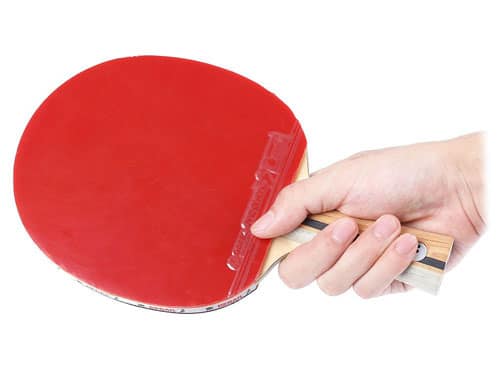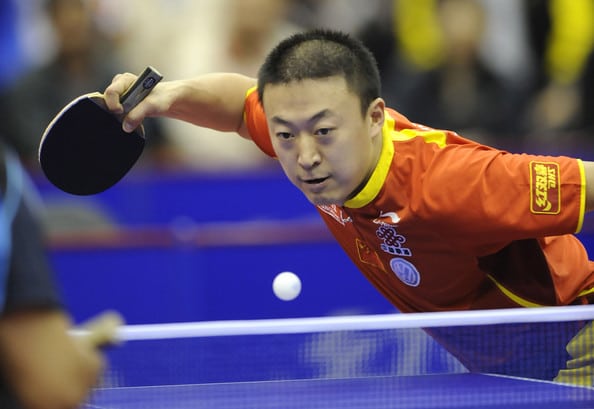Richard Prause is the German National coach and will try to give some helpful tips that are easy to learn for all those interested in improving their game. The former German national player has been working for the German Table Tennis Association as a national coach for ten years.
Since 2004 he has been the head coach of the men’s team. Timo Boll is one of the players under his charge. In this “Basic series,” Richard Prause points out where you should make contact with the ball so that you can mislead your opponent. Have fun with him and his advice.

Table of Contents
ToggleIt is essential where the ball hits the surface of the bat.
During the serve, details are essential. Many players don’t know where to make contact with the ball on their own bat. Depending on where the ball meets the bat, the rotation is different, and you have several possibilities to deceive or trick your opponent. The same service movement causes a different spin.
If you divide the bat into a top and a bottom half, you create more spin when the ball is hit with the bottom half. There is less or even no spin in the top half if I hold the bat a bit more straight at the same time. The violet arrow indicates the direction. The variation without or with a lot of spins is especially effective with short serves.
The same principle also applies for sidespin serves, only that the racket head is pointed downwards. If I hit the ball with the top half, I will produce less spin and more spin with the bottom half. It is connected with the fact that the bottom half of the bat’s speed is higher than that of the top half.
“Opposite movement” serves
Another famous trick relies on the principle that the ball is hit differently with the same stroke movement towards the ball, once before and once after the change of direction in movement. In picture 3a both contact points with the ball are indicated with a yellow ball. We call this service “opposition movement.”
If I meet the ball during the first part of the movement, we talk about a usual sidespin serve. Nothing happens during the backswing. If I hit the ball after the movement’s direction has changed, after the turning point, I create the opposite sidespin. Nothing happens during the start of the movement, while nothing happens towards the end of the movement during the first variety.
Depending on the bat’s position and the bat’s speed, I can vary the side-, back, or topspin a lot. The bat’s square position is more suitable for side-backspin variations, while the straight position is more suitable for pure sidespin or topspin.
How much do you need to train this?
Naturally, these serves need very intensive training if you want to manage them. But I must point out that many of the top players are not so concerned about the trick mentioned above but prefer a more fluent movement to trick the opponent with various positions or different bat speeds.
Timo Boll is mastering this particular “opposite movement” serve and is generally known as a good server. It is tough to see how much spin he has got in his serves. After the new service rules where you cannot hide your serve any longer, the service game has not become more accessible but more detailed.
In the end, it is all about not letting your opponent know how much spin there is in your serve. The best players work a lot with the exact amount of spin. It is no longer so difficult to recognize if there is a side-topspin or side-backspin in the ball because you can see it at all times. But it is still difficult to judge correctly how much spin there is in a side-backspin variety.
Wrist Action When Serving
When you serve in table tennis, do you lock your wrist on the free arm when you throw the ball upwards? Well, the wrist is natural like other shots while playing table tennis. Of course, the higher the throw, the more of the wrist movement. The lower, the smaller the movement, the harder to see.

For me, I believe in locking your wrist as your ball can be thrown consistently, whether it is a high ball or a low one.
To get excellent wrist action, in your spare time, you should carry out some wrist exercises. For me, I have been doing those non-stop, and I have flexible wrists from which I dig out extreme spin. It is of utmost necessity because I am dependent on my serve to set up an advantage!
For decisive wrist action, one can do the wrist curl with a dumb-bell. The exercise is simple.
First, you may put your hand along your upper thigh while holding a dumbbell with your wrist protruding out above your knee. Then slowly curl it downwards and moved it upwards. Do 3 sets of 10 repetitions. By practicing it frequently is one very effective way to strengthen your wrist.
For famous table tennis player like Michael Maze, I see him practice the wrist exercise in a good way. Yes, Maze never ceases to amaze me with his serves set-up. You may take a look at the video to see how he does.
Will I get injured because of doing too much wrist exercises?
Do I injure my wrist in any way? Many people have such concern, and they are scared that if they are doing so much wrist exercises, it will cause them to develop some joint pain soon. It is not to my knowledge that having such an issue for doing such exercise unless you have carpal tunnel syndrome will be different.
Anyway, I believe we will injure our body and arm more as we practice a lot on the forehand (FH) & backhand(BH) strokes more often than the serves. However, if we always do the proper warm-up before our practice and game, we will reduce the risk of getting injured.
One Awful Service Mistake You Probably Make
We ever talked about why having lots of serves is a weakness, not a strength. But there’s probably another service mistake you make. Probably lots more. Sorry to break it to you. But let’s take it easy and look at just one more for now.

You’ve probably heard over and over that short serves are vital if you want to progress to high-level table tennis. You know a short serve is detrimental to your game, just as much as a serve that drifts long.
A short serve in table tennis is defined as one that would bounce at least twice on your opponents’ side of the net if given a chance. Many players go wrong is putting too much importance on the ‘at least’ wording of that definition. More than two bounces should be even better right? Wrong.
A perfect short serve should bounce EXACTLY twice on your opponent’s side if given a chance. Furthermore, the second bounce should be as close to the end of the table as possible. Why?
Against aggressive opponents, who will attack any slightly long serve, it puts doubt in their mind about whether a serve is attackable, resulting in a hesitation that makes them slightly later in making their stroke. If they opt for a topspin stroke but contact the ball after the top of its bounce, it will invariably be a slow topspin, which will be easier to counter-attack for you.
Additionally, if the second bounce is further from the net, the first bounce will also be further from it. It means players who like to push short will be attempting to do so further from the net and, therefore, succeed less often.
Further evidence against the short-as-possible serve is that to serve very short, and the serve must bounce must be very close to the net on your side. In turn, it means a more vertical trajectory after that bounce to get over the net onto your opponent’s side.
Finally, this means it’s easier to make a mistake and have your serve bounce too high. A serve that bounces too high and too close to the net Fodder for any non-beginner opponent to receive any way they like, short or long, and make life very difficult for you.
But don’t take my word for it. Check out Australian #1 William Henzell’s analysis of Timo Boll and Ma Lin’s clash at the 2011 German Open. On the very first point, Henzell explains why Boll’s serve is the perfect length. Enjoy!

Warren Davies
Hi, I’m Warren Davies, a table tennis addict who loves sharing tips, reviews, and everything you need to level up your game. I’ve spent years playing, testing gear, and geeking out over the sport, and I’m here to make things simple and fun for players of all levels. When I’m not writing, you’ll probably find me perfecting my forehand or trying out the latest paddle.








